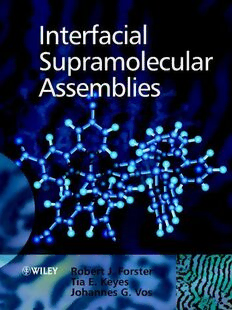Table Of ContentInterfacialSupramolecularAssemblies.JohannesG.Vos,RobertJ.ForsterandTiaE.Keyes
Copyright2003JohnWiley&Sons,Ltd.
ISBN:0-471-49071-7
INTERFACIAL
SUPRAMOLECULAR
ASSEMBLIES
INTERFACIAL
SUPRAMOLECULAR
ASSEMBLIES
Johannes G. Vos
Robert J. Forster
DublinCityUniversity,Ireland
Tia E. Keyes
DublinInstituteofTechnology,Ireland
Copyright2003 JohnWiley&SonsLtd,TheAtrium,SouthernGate,Chichester,
WestSussexPO198SQ,England
Telephone(+44)1243779777
Email(forordersandcustomerserviceenquiries):[email protected]
VisitourHomePageonwww.wileyeurope.comorwww.wiley.com
AllRightsReserved.Nopartofthispublicationmaybereproduced,storedinaretrievalsystemor
transmittedinanyformorbyanymeans,electronic,mechanical,photocopying,recording,scanning
orotherwise,exceptunderthetermsoftheCopyright,DesignsandPatentsAct1988orunderthe
termsofalicenceissuedbytheCopyrightLicensingAgencyLtd,90TottenhamCourtRoad,London
W1T4LP,UK,withoutthepermissioninwritingofthePublisher.RequeststothePublishershouldbe
addressedtothePermissionsDepartment,JohnWiley&SonsLtd,TheAtrium,SouthernGate,
Chichester,WestSussexPO198SQ,England,[email protected],orfaxedto(+44)
1243770620.
Thispublicationisdesignedtoprovideaccurateandauthoritativeinformationinregardtothesubject
mattercovered.ItissoldontheunderstandingthatthePublisherisnotengagedinrendering
professionalservices.Ifprofessionaladviceorotherexpertassistanceisrequired,theservicesofa
competentprofessionalshouldbesought.
OtherWileyEditorialOffices
JohnWiley&SonsInc.,111RiverStreet,Hoboken,NJ07030,USA
Jossey-Bass,989MarketStreet,SanFrancisco,CA94103-1741,USA
Wiley-VCHVerlagGmbH,Boschstr.12,D-69469Weinheim,Germany
JohnWiley&SonsAustraliaLtd,33ParkRoad,Milton,Queensland4064,Australia
JohnWiley&Sons(Asia)PteLtd,2ClementiLoop#02-01,JinXingDistripark,Singapore129809
JohnWiley&SonsCanadaLtd,22WorcesterRoad,Etobicoke,Ontario,CanadaM9W1L1
Wileyalsopublishesitsbooksinavarietyofelectronicformats.Somecontentthatappears
inprintmaynotbeavailableinelectronicbooks.
BritishLibraryCataloguinginPublicationData
AcataloguerecordforthisbookisavailablefromtheBritishLibrary
ISBN0-471-49071-7
Typesetin10.5/12.5ptPalatinobyLaserwordsPrivateLimited,Chennai,India
PrintedandboundinGreatBritainbyAntonyRoweLtd,Chippenham,Wiltshire
Thisbookisprintedonacid-freepaperresponsiblymanufacturedfromsustainableforestry
inwhichatleasttwotreesareplantedforeachoneusedforpaperproduction.
Contents
1
Introduction
1
1.1
IntroductoryRemarks 1
1.2
InterfacialSupramolecularChemistry 2
1.3
ObjectivesofthisBook 4
1.4
TestingContemporaryTheoryUsingISAs 4
1.5
AnalysisofStructureandProperties 5
1.6
FormationandCharacterizationofInterfacialSupramolecular
Assemblies 5
1.7
ElectronandEnergyTransferProperties 6
1.8
InterfacialElectronTransferProcessesatModified
SemiconductorSurfaces 6
FurtherReading 6
2
Theoretical Framework for Electrochemical
and Optical Processes
9
2.1
Introduction 9
2.2
ElectronTransfer 9
2.2.1 HomogenousElectronTransfer 10
2.2.2 HeterogeneousElectronTransfer 21
vi Contents
2.3
PhotoinducedProcesses 28
2.3.1 PhotochemistryandPhotophysicsofSupramolecularMaterials 28
2.3.2 PhotoinducedElectronTransfer 31
2.3.3 PhotoinducedEnergyTransfer 33
2.3.4 PhotoinducedMolecularRearrangements 36
2.4
PhotoinducedInterfacialElectronTransfer 41
2.4.1 Dye-SensitizedPhotoinducedElectronTransfer
atMetalSurfaces 43
2.4.2 Dye-SensitizedPhotoinducedElectronTransfer
atSemiconductorSurfaces 44
2.4.3 PhotoinducedInterfacialEnergyTransfer 45
2.5
ElucidationofExcited-StateMechanisms 46
2.6
Conclusions 48
ReferencesandNotes 48
3
Methods of Analysis
51
3.1
StructuralCharacterizationofInterfacialSupramolecular
Assemblies 51
3.1.1 ScanningProbeMicroscopy 52
3.1.2 ScanningElectrochemicalMicroscopy 53
3.1.3 ContactAngleMeasurements 55
3.1.4 Mass-SensitiveApproaches 56
3.1.5 Ellipsometry 59
3.1.6 SurfacePlasmonResonance 60
3.1.7 NeutronReflectivity 62
3.2
VoltammetricPropertiesofInterfacialSupramolecular
Assemblies 63
3.2.1 ElectrochemicalPropertiesofanIdealRedox-ActiveAssembly 63
3.2.2 TheFormalPotential 66
3.2.3 EffectofLateralInteractions 66
3.2.4 DiffusionalChargeTransportthroughThinFilms 67
3.2.5 RotatingDiskVoltammetry 68
3.2.6 InterfacialCapacitanceandResistance 70
3.3
SpectroscopicPropertiesofInterfacialSupramolecular
Assemblies 70
3.3.1 LuminescenceSpectroscopy 71
3.3.2 FluorescenceDepolarization 72
3.3.3 EpifluorescentandConfocalMicroscopy 73
Contents vii
3.3.4 Near-FieldScanningOpticalMicroscopy 74
3.3.5 RamanSpectroscopy 75
3.3.6 SecondHarmonicGeneration 78
3.3.7 Single-MoleculeSpectroscopy 78
3.3.8 Spectroelectrochemistry 79
3.3.9 Intensity-ModulatedPhotocurrentSpectroscopy 80
3.4
Time-ResolvedSpectroscopyofInterfacialSupramolecular
Assemblies 81
3.4.1 FlashPhotolysis 81
3.4.2 Time-ResolvedLuminescenceTechniques 82
3.4.3 Femtochemistry 83
3.5
Conclusions 85
References 85
4
Formation and Characterization of Modified
Surfaces
87
4.1
Introduction 87
4.2
SubstrateChoiceandPreparation 89
4.3
FormationofSelf-AssembledMonolayers 90
4.3.1 Solution-PhaseDeposition 91
4.3.2 ElectrochemicalStrippingandDeposition 93
4.3.3 ThermodynamicsofAdsorption 94
4.3.4 Double-LayerStructure 99
4.3.5 Post-DepositionModification 104
4.4
StructuralCharacterizationofMonolayers 105
4.4.1 PackingandAdsorbateOrientation 105
4.4.2 SurfaceProperties 108
4.5
ElectrochemicalCharacterization 109
4.5.1 GeneralVoltammetricPropertiesofRedox-ActiveMonolayers 109
4.5.2 MeasuringtheDefectDensity 110
4.6
MultilayerFormation 112
4.6.1 ElectrostaticallyDrivenAssemblies 112
4.6.2 OrderedProteinLayers 115
4.6.3 Surfactant-BasedMultilayerAssemblies 115
viii Contents
4.7
PolymerFilms 117
4.7.1 FilmDepositionMethods 118
4.7.2 SyntheticProceduresforthePreparationofRedox-Active
Polymers 121
4.7.3 SyntheticMethodsforthePreparationofConducting
Polymers 126
4.8
StructuralFeaturesandStructure–PropertyRelationships
ofThinPolymerFilms 134
4.8.1 StructuralAssessmentofRedoxPolymersusingNeutron
Reflectivity 134
4.8.2 StructuralFeaturesofElectrostaticallyDepositedMultilayer
Assemblies 138
4.8.3 Self-AssembledMonolayerFilmsofThiol-DerivatizedPolymers 140
4.8.4 StructuralPropertiesofBlockCopolymers 141
4.8.5 DomainControlwithStyrene–MethylMethacrylate
Copolymers 143
4.8.6 Structure–ConductivityRelationshipsforAlkylthiophenes 144
4.9
BiomimeticAssemblies 146
4.9.1 ProteinLayers 147
4.9.2 BiomoleculeBindingtoSelf-AssembledMonolayers 148
4.9.3 RedoxPropertiesofBiomonolayers 149
4.10
Conclusions 150
References 151
5
Electron and Energy Transfer Dynamics
153
5.1
Introduction 153
5.2
ElectronandEnergyTransferDynamicsofAdsorbedMonolayers 154
5.2.1 DistanceDependenceofElectronTransfer 155
5.2.2 ResonanceEffectsonElectronTransfer 157
5.2.3 ElectrodeMaterialEffectsonElectronTransfer 162
5.2.4 EffectofBridgeConjugationonElectronTransferDynamics 165
5.2.5 RedoxPropertiesofDimericMonolayers 167
5.2.6 CoupledProtonandElectronTransfersinMonolayers 169
5.2.7 Redox-SwitchableLateralInteractions 174
5.2.8 ElectronTransferDynamicsofElectronicallyExcitedStates 177
5.2.9 ConformationalGatinginMonolayers 180
5.2.10 ElectronTransferwithinBiosystems 183
5.2.11 Protein-MediatedElectronTransfer 183
Contents ix
5.3
NanoparticlesandSelf-AssembledMonolayers 185
5.3.1 ConductivitiesofSingleClusters–Molecular
Switching 186
5.4
ElectroanalyticalApplications 187
5.4.1 MicroarrayElectrodes 187
5.4.2 SelectivePermeation 188
5.4.3 PreconcentrationandSelectiveBinding 188
5.4.4 SAM-BasedBiosensors 189
5.4.5 KineticSeparationofAmperometricSensor
Responses 190
5.5
Light-AddressableAssemblies 192
5.6
Surface–PhotoactiveSubstrateInteractions 193
5.7
PhotoactiveSelf-AssembledMonolayers 194
5.8
PhotocurrentGenerationatModifiedMetalElectrodes 194
5.9
PhotoinducedMolecularSwitching 199
5.10
LuminescentFilms 206
5.11
PhotoinducedProcessesinBio-SAMs 211
5.12
PhotoinducedElectronandEnergyTransferinSAMs 215
5.12.1 DistanceDependenceofPhotoinducedElectron
andEnergyTransfer 216
5.12.2 PhotoinducedEnergyTransfer 219
5.12.3 MonolayerMobilityandSubstrateRoughness 220
5.13
MultilayerAssemblies 223
5.13.1 PhotoinducedChargeSeparationinMultilayers 229
5.14
ElectrochemistryofThinRedox–ActivePolymerfilms 235
5.14.1 HomogeneousChargeTransport 236
5.14.2 ElectrochemicalQuartzCrystalMicrobalance
Studies 239
5.14.3 InterfacialElectrocatalysis 240
5.15
ConclusionsandFutureDirections 247
5.15.1 ChallengesfortheNextDecade 248
References 249
x Contents
6
Interfacial Electron Transfer Processes at
Modified Semiconductor Surfaces
253
6.1
Introduction 253
6.2
StructuralandElectronicFeaturesofNanocrystallineTiO
2
Surfaces 254
6.2.1 ElectronicPropertiesofBulkTiO 254
2
6.2.2 ElectronicPropertiesofNanoparticles 256
6.2.3 PreparationandStructuralFeaturesofNanocrystalline
TiO Surfaces 259
2
6.3
PhysicalandChemicalPropertiesofMolecular
Components 262
6.3.1 ChargeSeparationatNanocrystallineTiO Surfaces 267
2
6.4
PhotovoltaicCellsBasedonDye-SensitizedTiO2 269
6.5
PhotoinducedChargeInjection 273
6.5.1 ExternalFactorswhichAffectPhotoinducedChargeInjection 275
6.5.2 CompositionofElectrolyte 275
6.5.3 TheEffectofRedoxPotential 279
6.6
InterfacialSupramolecularAssemblies 280
6.6.1 RutheniumPhenothiazineAssembly 280
6.6.2 Rhodium–RutheniumAssembly 282
6.6.3 RutheniumOsmiumAssembly 286
6.7
ElectrochemicalBehaviorofNanocrystallineTiO2 Surfaces 291
6.7.1 ElectrochromicDevices 294
6.8
AlternativeSemiconductorSubstrates 297
6.9
ConcludingRemarks 299
References 300
7
Conclusions and Future Directions
301
7.1
Conclusions–WheretofromHere......? 301
7.2
MolecularSelf-Assembly 301
Contents xi
7.3
MolecularComponentsandNanotechnology 302
7.4
Biosystems 303
7.5
‘SmartPlastics’ 304
7.6
InterfacialPhotochemistryatConductingSurfaces 305
7.7
ModifiedSemiconductorSurfaces 306
7.8
ConcludingRemarks 306
Index 309

